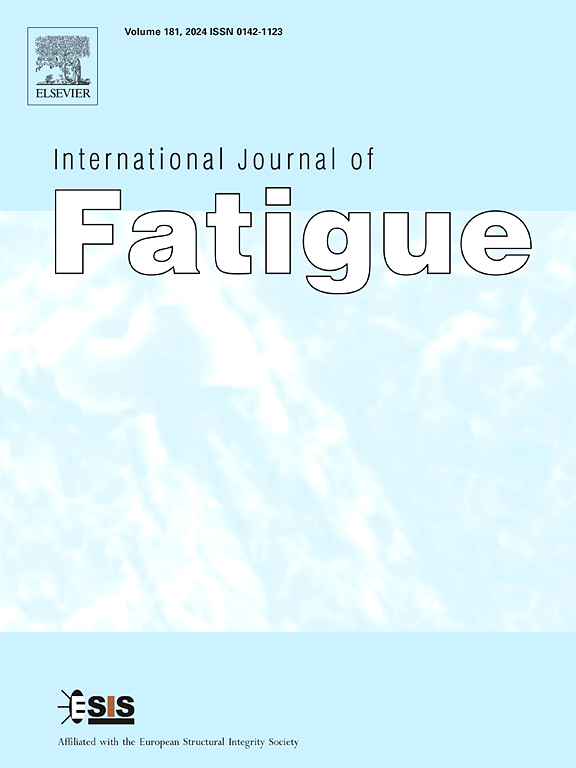Synchrotron X-ray 3D characterisation of fatigue crack initiation during in-situ torsion cyclic tests
IF 5.7
2区 材料科学
Q1 ENGINEERING, MECHANICAL
引用次数: 0
Abstract
This paper focuses on the characterisation of fatigue crack initiation mechanisms under fully reversed torsional loads for the porosity-containing cast AlSi7Mg0.3 aluminium alloy by synchrotron X-ray tomographic imaging and Diffraction Contrast Tomography (DCT). The aim is to analyse the relation between crack initiation and the microstructure, in the fatigue regime close to the fatigue limit of the material (fatigue lives of approximately cycles). In-situ torsion fatigue tests have been conducted at the European Synchrotron Radiation Facility. A large number of cracks (approximately 80 cracks) were analysed, at the surface and in the bulk, highlighting the role of the surrounding microstructure on the crack initiation mechanisms. Contrary to uniaxial loads in which fatigue crack initiation from casting pores in an opening mode (mode I) is generally only observed for this material, it is shown in this work that multiple crack initiations mechanisms can appear simultaneously under torsional loads. This is very interesting because it is possible to analyse different mechanisms (and the effect of the surrounding microstructure) using the same specimen, that is under identical loading conditions. More precisely, two different crack initiation mechanisms were observed. The first mechanism involves intra-granular fatigue crack initiation from Persistent Slip Bands (PSBs) formed on the slip system with the highest Schmid factor. For this mechanism, the grain orientation is the key parameter. A shear stress threshold of approximately 80 MPa is observed to trigger this mechanism. The presence of a pore, in the crack initiation zone reduces this threshold. The second mechanism concerns crack initiation from pores, in mode I, on planes of maximum principal stress. No link to the local grain orientation was found in that case. The pore size is the key factor governing this crack initiation mechanism. Regarding the competition between these mechanisms in the formation of the final crack, it was observed that at high applied stress, the cracks initiated from PSBs are dominant due to their high density and high growth rates resulting from coalescence. At lower stress, cracks initiated from pores are dominant, mainly because of the little effect of grain boundaries and eutectic zones, while most of cracks initiated from PSBs are arrested within the grain where they have initiated.

原位扭转循环试验中疲劳裂纹萌生的同步加速器x射线三维表征
本文采用同步x射线断层成像和衍射对比断层成像(DCT)技术研究了含孔铸态AlSi7Mg0.3铝合金在完全扭转载荷作用下的疲劳裂纹萌生机制。目的是分析在接近材料疲劳极限的疲劳状态下(疲劳寿命约为2×106次)裂纹萌生与微观组织之间的关系。在欧洲同步辐射设施进行了现场扭转疲劳试验。在表面和整体上分析了大量裂纹(大约80个裂纹),突出了周围微观结构在裂纹起裂机制中的作用。在单轴载荷下,通常只在这种材料中观察到铸造孔以开口模式(I型)引发疲劳裂纹,与此相反,这项工作表明,在扭转载荷下,多种裂纹引发机制可以同时出现。这是非常有趣的,因为在相同的加载条件下,使用相同的试样可以分析不同的机制(以及周围微观结构的影响)。更确切地说,观察到两种不同的裂纹起裂机制。第一种机制涉及到在施密德系数最高的滑移系统上形成的持续滑移带(PSBs)引起的颗粒内疲劳裂纹萌生。对于这一机制,晶粒取向是关键参数。观察到约80 MPa的剪应力阈值可触发该机制。裂纹萌生区孔隙的存在降低了这一阈值。第二种机制是在最大主应力平面上,以模式I从孔隙中起裂。在这种情况下,没有发现与当地谷物取向有关。孔隙大小是控制裂纹起裂机制的关键因素。关于这些机制在最终裂纹形成过程中的竞争,我们观察到,在高外加应力下,由psb引发的裂纹由于其高密度和高生长速率而占主导地位。在较低应力条件下,由于晶界和共晶带的影响较小,由孔隙引发的裂纹占主导地位,而大多数由psb引发的裂纹被抑制在其产生的晶粒内。
本文章由计算机程序翻译,如有差异,请以英文原文为准。
求助全文
约1分钟内获得全文
求助全文
来源期刊

International Journal of Fatigue
工程技术-材料科学:综合
CiteScore
10.70
自引率
21.70%
发文量
619
审稿时长
58 days
期刊介绍:
Typical subjects discussed in International Journal of Fatigue address:
Novel fatigue testing and characterization methods (new kinds of fatigue tests, critical evaluation of existing methods, in situ measurement of fatigue degradation, non-contact field measurements)
Multiaxial fatigue and complex loading effects of materials and structures, exploring state-of-the-art concepts in degradation under cyclic loading
Fatigue in the very high cycle regime, including failure mode transitions from surface to subsurface, effects of surface treatment, processing, and loading conditions
Modeling (including degradation processes and related driving forces, multiscale/multi-resolution methods, computational hierarchical and concurrent methods for coupled component and material responses, novel methods for notch root analysis, fracture mechanics, damage mechanics, crack growth kinetics, life prediction and durability, and prediction of stochastic fatigue behavior reflecting microstructure and service conditions)
Models for early stages of fatigue crack formation and growth that explicitly consider microstructure and relevant materials science aspects
Understanding the influence or manufacturing and processing route on fatigue degradation, and embedding this understanding in more predictive schemes for mitigation and design against fatigue
Prognosis and damage state awareness (including sensors, monitoring, methodology, interactive control, accelerated methods, data interpretation)
Applications of technologies associated with fatigue and their implications for structural integrity and reliability. This includes issues related to design, operation and maintenance, i.e., life cycle engineering
Smart materials and structures that can sense and mitigate fatigue degradation
Fatigue of devices and structures at small scales, including effects of process route and surfaces/interfaces.
 求助内容:
求助内容: 应助结果提醒方式:
应助结果提醒方式:


